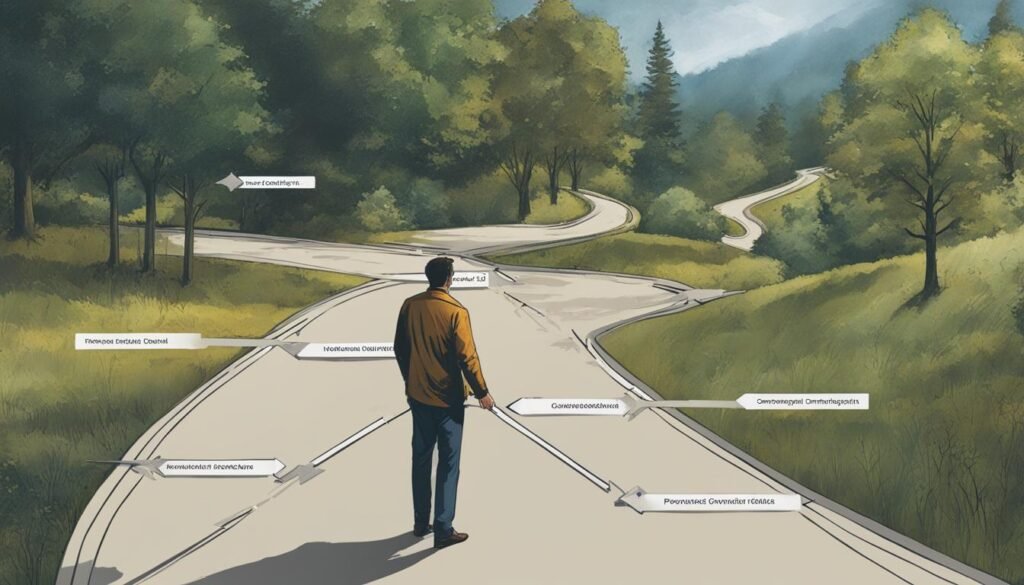Thinking in Bets by Annie Duke: Improve Your Decision-Making Skills with Poker Strategies and Probability
December 4, 2023 | by businessbooksmarts.com

Are you tired of making decisions that don’t quite pan out? Do you find yourself second-guessing your choices or regretting missed opportunities? “Thinking in Bets” by Annie Duke may be just what you need to sharpen your decision-making skills.
In this book, Duke draws on her experience as a professional poker player to explore how principles from the game of poker and probability can be applied to decision making in various aspects of life. Whether you’re facing a complex business decision or a personal dilemma, the strategies and techniques outlined in this book can help you make more informed and confident choices.
With a focus on critical thinking and decision analysis, “Thinking in Bets” provides a framework for assessing risk, managing uncertainty, and weighing the potential outcomes of different options. By embracing risk and learning from mistakes, you can become a more effective decision maker and achieve greater success in your personal and professional life.
Key Takeaways:
- Apply principles from poker and probability to improve decision making
- Assess risk and weigh potential outcomes
- Embrace risk and learn from mistakes
- Manage uncertainty and make confident decisions
- Think critically and analyze decisions for optimal outcomes
Understanding Decision Making
Decision making is a fundamental part of our daily lives. From choosing what outfit to wear, to making important career decisions, we are constantly faced with choices that impact our lives. However, decision making is not always simple, as it involves weighing different options and considering potential outcomes.
In order to make sound decisions, it is important to develop critical thinking skills, which allow us to analyze information and make informed choices. Critical thinking involves questioning assumptions, evaluating evidence, and considering different perspectives. By developing these skills, we can become better decision makers and improve our overall quality of life.
The Process of Decision Making
The process of decision making involves several steps, including:
- Identifying the problem or decision to be made
- Gathering information and generating options
- Evaluating the options and considering potential outcomes
- Making a decision and taking action
- Evaluating the outcome and learning from the experience
Throughout this process, it is important to remain objective and consider all relevant factors. However, our biases, emotions, and past experiences can influence our decision making, leading to suboptimal choices. By being aware of these factors and actively working to overcome them, we can make better decisions and achieve our goals more effectively.
The Importance of Critical Thinking
Critical thinking is essential for effective decision making. By asking questions, evaluating evidence, and considering different perspectives, we can make more informed choices. However, critical thinking requires effort and practice, as it involves challenging our own assumptions and beliefs.
One useful technique for developing critical thinking skills is to engage in active listening and questioning. By actively listening to others and asking questions, we can gain a better understanding of different perspectives and consider them when making decisions.
“Critical thinking is the intellectually disciplined process of actively and skillfully conceptualizing, applying, analyzing, synthesizing, and/or evaluating information gathered from, or generated by, observation, experience, reflection, reasoning, or communication, as a guide to belief and action.” – Foundation for Critical Thinking
In summary, understanding the process of decision making and developing critical thinking skills are vital for making sound decisions and achieving our goals. By practicing active listening and questioning, we can enhance our abilities and become more effective decision makers.
The Role of Probability
Probability is the cornerstone of decision analysis. Understanding probability helps us assess the likelihood of different outcomes and make informed choices.
Probability is the measure of how likely an event is to occur. It ranges from 0 to 1, where 0 denotes no chance of an event occurring, and 1 denotes that the event is certain to occur.
Probabilistic thinking helps us weigh the potential risks and rewards of different options. By considering the probability of each outcome, we can make calculated decisions that have a higher likelihood of success.
Decision analysis uses a variety of techniques to calculate the probability of different outcomes. These techniques include decision trees, simulations, and Bayesian analysis.
Decision trees are diagrams that help us visualize different outcomes and the probabilities associated with each outcome. Simulations use computer models to simulate real-world situations and calculate the probability of different outcomes. Bayesian analysis uses prior knowledge to update our understanding of probabilities as new information becomes available.
Probability helps us make more rational decisions by reducing our reliance on intuition and emotion. By understanding the probability of different outcomes, we can make more objective decisions that are based on facts and data rather than personal biases.
“The science of probability is the gatekeeper to decision-making.” – Amir D. Aczel
Embracing Risk in Decision Making
When it comes to decision making, risk is often viewed as a negative factor. Many people avoid taking risks altogether, fearing the potential for failure or loss. However, embracing risk can actually be beneficial in certain situations.
Assessing risk involves weighing the potential downsides against the potential upsides. This type of analysis can help you make calculated decisions that have the potential for greater rewards. It can also help you avoid missed opportunities due to fear or hesitation.
“You can’t win at poker if you don’t take some risks. But it’s not about blindly taking risks – it’s about taking calculated risks based on the information you have.”
– Annie Duke, Thinking in Bets
In order to embrace risk, it’s important to understand the potential consequences of different outcomes. This involves assessing the likelihood of both positive and negative outcomes, and weighing the potential rewards against the potential risks. It also involves being comfortable with uncertainty and the possibility of failure.
While it may seem counterintuitive, embracing risk can actually increase your chances of success over the long term. By taking calculated risks, you open yourself up to new opportunities and possibilities that may not have been available if you had played it safe.
Of course, this doesn’t mean you should take unnecessary risks or make decisions impulsively. Rather, it means learning to analyze risk and make carefully considered decisions based on the information you have at hand.
By embracing risk and overcoming the fear of failure, you can make bolder decisions that have the potential for greater rewards. So next time you’re faced with a decision that involves risk, consider this: taking the risk may just pay off in the end.
Applying Poker Strategies for Better Decision Making
Have you ever considered using poker strategies to make better decisions in life? With the principles of poker, you can learn to manage uncertainty, read opponents, and make strategic bets.
One key poker strategy that applies to decision-making is understanding expected value. In poker, expected value refers to the average outcome of a decision if it were repeated multiple times. In life, we can use this idea to analyze decisions and evaluate potential outcomes.
“When we think probabilistically about our decisions, we are betting. And like any good poker player, we can get better at it with practice.” – Annie Duke
Another poker strategy that can be applied to decision-making is understanding pot odds. In poker, pot odds refer to the ratio of the amount of money in the pot to the amount it would cost to call a bet. In decision-making, we can use this to assess the potential risk and potential reward of different options.
Finally, reading opponents is an essential skill in poker, and it can also be useful in decision-making. By understanding the motivations and perspectives of others involved in a decision, we can anticipate their actions and choose the best course of action for ourselves.
By applying these poker strategies to decision-making in various areas of life, you can learn to think in bets and make more confident choices. Take a chance and give it a try!
Analyzing Decisions
When it comes to decision-making, there are many factors to consider. Critical thinking and decision analysis can help you make informed choices that align with your goals. One important aspect of decision-making is analyzing the potential outcomes of each option. By evaluating the expected value of different choices, you can determine which one is most likely to lead to success.
Decision analysis involves breaking down complex decisions into smaller, more manageable components. This allows you to evaluate the potential risks and rewards of each option and weigh them against each other. One useful tool for decision analysis is the decision tree, which is a visual representation of the possible outcomes of a decision.
Assessing Expected Value
Expected value is a concept that is central to decision analysis. It involves assessing the potential outcome of each option and weighing it against its likelihood of occurring. To calculate expected value, you multiply the probability of each possible outcome by its potential value, and then add up the results.
For example, let’s say you are considering two job offers. Job A pays $50,000 per year, while Job B pays $70,000 per year but has a 50% chance of being eliminated within the first year. To calculate the expected value of Job B, you would multiply the potential value of the job ($70,000) by its probability (.5), which gives you an expected value of $35,000. You would then compare this to the expected value of Job A, which is $50,000, and make your decision accordingly.
Evaluating Risk
When analyzing decisions, it is important to consider the potential risks involved. This requires a clear understanding of the potential consequences of each option, as well as the likelihood of those consequences occurring. By weighing the potential risks and rewards of each option, you can make a more informed choice.
However, it is also important to remember that taking risks can sometimes lead to greater rewards. By embracing risk and being open to uncertainty, you may be able to achieve more than you otherwise would have. The key is to balance the potential risks with the potential rewards and make a calculated decision.
“The ability to analyze decisions and evaluate their potential outcomes is a crucial skill for success in any area of life.”
Overall, decision analysis and critical thinking are essential skills for making informed choices. By assessing the potential outcomes of each option, evaluating the expected value, and weighing the potential risks and rewards, you can make more confident decisions that align with your goals.
Assessing Trade-Offs
When it comes to decision making, it’s important to understand that every choice involves trade-offs. By making one decision, you may gain certain benefits but lose out on others. Assessing trade-offs is a critical component of making informed decisions.
One way to assess trade-offs is by creating a pros and cons list. Write down all the potential benefits and drawbacks of each option you are considering. Think about how each option aligns with your priorities and values.
It’s also important to consider the opportunity cost of each decision. Opportunity cost refers to the benefits you could have received from the option you didn’t choose. For example, if you choose to attend one event, you miss out on the benefits of attending another event that’s happening at the same time.
Critical thinking is essential when assessing trade-offs. It allows you to evaluate the potential risks and rewards of each option. By thinking critically, you can make decisions that align with your priorities and values.
“In decision making, the most important thing is to know what you are saying ‘no’ to.”
Keep in mind that trade-offs are not always black and white. There may be options that offer a blend of benefits and drawbacks. It’s up to you to decide which option is the best fit for your goals and aspirations.
By assessing trade-offs, you can make confident decisions that align with your values and priorities. Don’t be afraid to take the time to evaluate your options and think critically about the potential benefits and drawbacks of each one.

Managing Uncertainty
Managing uncertainty is a crucial part of decision making. Risks are inherent in every decision, and acknowledging them is the first step towards making informed choices. Instead of hoping for the best outcome, it’s important to consider all possibilities and plan accordingly. In other words, you should always have a backup plan or contingency strategy.
One way to manage uncertainty is to break down the decision into smaller, more manageable components. This can help you identify potential risks and weigh the probabilities of each outcome. Additionally, seeking out advice or opinions from others can provide valuable insights and help you see the decision from different perspectives.
It’s also important to recognize that there may not be a “right” or “wrong” decision in every situation. Sometimes, the best option is simply the one that aligns with your values and goals. It’s okay to take calculated risks and make decisions based on limited information, as long as you’re aware of the potential consequences.
“Uncertainty is an uncomfortable position. But certainty is an absurd one.” – Voltaire
One strategy for managing uncertainty is to use decision trees. A decision tree is a visual tool that helps you map out the possible outcomes of a decision and the probability of each outcome. This can help you see the potential risks and rewards of each option and make a more informed choice.
Another key aspect of managing uncertainty is to stay flexible and open to adjusting your decision as new information arises. It’s important to be willing to pivot and change course if necessary, rather than sticking to a decision that is no longer in your best interest.
By adopting a mindset of managing uncertainty, you can make more confident decisions even in unpredictable situations. Remember, risks are unavoidable, but with the right strategies, you can minimize their impact and increase your chances of success.
Learning from Mistakes
One of the most valuable skills in decision making is the ability to learn from mistakes. Recognizing and analyzing past mistakes can provide valuable insights into our decision-making processes and help us avoid repeating them in the future.
When we make a mistake, it’s important to take the time to reflect on what went wrong and why. This involves stepping back from the situation and analyzing our decision-making process objectively. Did we consider all the available information? Were we influenced by biases or emotions? Did we assess the potential risks and rewards properly?
By asking these types of questions, we can identify areas where we need to improve and develop strategies to avoid similar mistakes in the future. For example, if we realize that we tend to make impulsive decisions based on emotions, we can work on developing better emotional regulation skills.
It’s also important to avoid being too hard on ourselves when we make mistakes. Instead, we should view them as opportunities for growth and learning. By adopting a growth mindset, we can approach mistakes with curiosity and a desire to learn, rather than feeling ashamed or embarrassed.
“Mistakes are always forgivable if one has the courage to admit them.” – Bruce Lee
Learning from mistakes is an ongoing process, and it requires a commitment to self-reflection and improvement. By embracing our mistakes and using them as opportunities for growth, we can become better decision makers and achieve greater success in all areas of life.
Overcoming Decision Biases
Our decision-making process can be influenced by various biases that can lead to suboptimal choices. One common bias is confirmation bias, which is the tendency to seek out information that confirms our existing beliefs and ignore information that contradicts them. This can lead to narrow-minded thinking and prevent us from considering alternative options.
Another bias is the sunk cost fallacy, where we continue investing in a decision because we have already invested time or money into it, even if it no longer makes sense to do so. This can result in a waste of resources and an inability to change course when necessary.
To overcome these biases, it’s important to foster objective thinking and consider a range of perspectives. This entails seeking out information that challenges our assumptions and being open to changing our minds if necessary. It also involves being willing to cut our losses and move on from decisions that are no longer viable.
“The first principle is that you must not fool yourself, and you are the easiest person to fool.”
– Richard Feynman
By acknowledging our own biases and limitations, we can become more aware of how they impact our decision-making and take steps to overcome them. This can lead to more rational and effective choices that are less influenced by emotion and more guided by critical thinking.

Applying Decision Strategies in Life
Decision making is an integral part of our daily lives. From deciding what to wear to choosing a career path, we are constantly making choices that affect our future. The concepts and strategies discussed in “Thinking in Bets by Annie Duke” can be applied to various aspects of life to help us make more confident and informed decisions.
Personal Development
When it comes to personal growth, decision making plays a crucial role. Whether it’s deciding to take on a new challenge or setting goals for the future, critical thinking skills are key. By analyzing the potential outcomes and weighing the risks and rewards, we can make choices that align with our values and aspirations.
“The choices we make determine the course of our lives.”
Embracing risk and managing uncertainty can also be important when it comes to personal development. It’s easy to get stuck in a comfort zone, but taking calculated risks can lead to new opportunities for growth and learning.
Relationships
When it comes to relationships, decision making can be particularly challenging. Emotions and biases can cloud our judgment, leading to suboptimal choices. By applying critical thinking skills and assessing trade-offs, we can make choices that strengthen our relationships and foster healthy communication.
Learning from mistakes is also important in relationships. By reflecting on past decisions and analyzing their outcomes, we can improve our communication and build stronger connections with those around us.
Career
Decision making is a crucial aspect of career success. From choosing a job to negotiating a salary, our choices can have a significant impact on our professional lives. By applying decision analysis and critical thinking skills, we can make informed choices that align with our career goals and aspirations.
Overcoming decision biases and managing uncertainty can also be important when it comes to career success. By fostering objective thinking and embracing risk, we can seize new opportunities and advance our careers.
Overall, the concepts and strategies discussed in “Thinking in Bets by Annie Duke” can be applied to various areas of life. By thinking in bets and approaching decision making with a critical mindset, we can make more confident and informed choices that lead to greater success and fulfillment.
Conclusion
After delving into the world of decision making with “Thinking in Bets by Annie Duke,” it’s clear that we can benefit greatly from applying insights from poker and probability to our everyday choices. By embracing risk, managing uncertainty, and analyzing decisions, we can increase our chances of success and make more informed choices.
It’s important to understand the role of probability and learn how to assess potential outcomes before making a decision. By evaluating trade-offs and avoiding decision biases, we can foster objective thinking and make more rational choices.
It’s equally crucial to learn from mistakes, reflect on past decisions, and use them as opportunities for growth. By applying these decision strategies to different areas of life, such as relationships, career, and personal development, we can think in bets and make more confident decisions.
In short, “Thinking in Bets by Annie Duke” provides a valuable framework for critical thinking and decision making that can benefit us all. By embracing the lessons and concepts presented in this book, we can improve our decision making skills and increase our chances of success.
RELATED POSTS
View all


